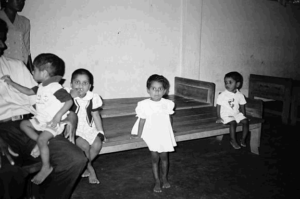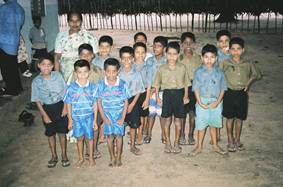 by Rob Bloom, June 5, 2004
by Rob Bloom, June 5, 2004
They were a focal point during my visit to Tamil Eelam, Sri Lanka and, as described in this article, I found the visits to be very fulfilling yet disconcerting at the same time.Prakash Rajasundram, our hosts, and I visited three Illams: they are named Kurukulam, Senth-Cholai, and Kantharuban Arevuchcholai.In these and other Illams, the children are the innocent victims of the war between the Sri Lankan government and the Liberation Tigers of Tamil Eelam (LTTE).These children have lost both of their parents to the conflict.
That is, at the “visitor’s hut”, away from the children, the “tour guide” gives a description of the Illam and answers any questions.Sometimes photo albums are passed around showing the children excelling in both academic (eg. winning a math contest) and extra curricular (eg. learning karate) pursuits. A walking tour of the Illam is next and the visitors are brought to a room containing a handful of toddlers – the perfect candidates with whom the visitor can form a bond or some sort of attachment.Some of them cling to the affection given to them.Others take time to “warm up” and yet some kids remain shy and sad and I wondered about them.I’m told even the seemingly happy children can go into a disturbed mode where they burst out crying or become mute at unexpected times.Much of it is unexplainable by the staff but some traumatic memory is clearly triggering the behaviour.
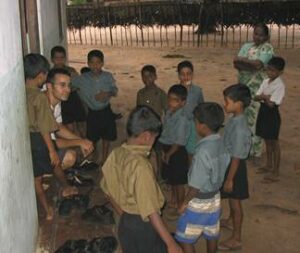 I approached 8 year olds out in the field who had stopped playing soccer when they noticed me.I asked one of the boys his name and age and this initiated all the boys to introduce themselves (name, age, where they go to school, etc) in a rehearsed yet gentlemanly way.I then pulled out a wrinkled piece of paper from my pocket on which Tamil “small chat” phrases were written.I said them aloud and they understood!I was connecting!
I approached 8 year olds out in the field who had stopped playing soccer when they noticed me.I asked one of the boys his name and age and this initiated all the boys to introduce themselves (name, age, where they go to school, etc) in a rehearsed yet gentlemanly way.I then pulled out a wrinkled piece of paper from my pocket on which Tamil “small chat” phrases were written.I said them aloud and they understood!I was connecting!
Expressing my interest to the children, they began to speak out erratically – none of it I could understand.The mother/teacher raised her voice and seemed concerned at the sight of us approaching the bunker and then she went to fetch the tour guide.I admit, I tried to peer inside but I simply wanted a photograph.The concerned tour guide attempted to describe the bunkers, in broken English.I heard the word “snakes” and that was enough to understand that it was dangerous to enter the bunker.
Here are my observations and answered questions in point form below.
- As the war started and progressed, the majority of the homes was run by either the Tiger organization and personally mandated and “christened” by Velupillai Pirabakaran himself (the leader of the LTTE) or by the T.R.O. (the Tamil Rehabilitation Organization).
- Many Illams were created.Eventually, the TRO took over some homes from the overwhelmed Tiger administration.Still yet, other groups have come to help out and raise funds for the TRO such as the TCEF (Tamil Children’s Endowment Fund).
- About 500 to 600 children reside at Kurukulam alone.The Illams receive electricity by generators only part of the day.This is a relatively recent “luxury”.
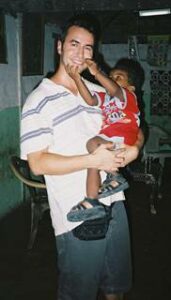 A homely atmosphere is strived for.
A homely atmosphere is strived for.
- The children were displaced to escape carnage but with empty hands and many children cannot forget this.They returned to the homes in 2002 shortly after the cease-fire and have rebuilt.
- Eg. Kurukulam currently has a one year old but he arrived at 6 months when his mother passed away.Apparently, the boy was very malnourished when he was found.He has been rehabilitated and is now looking healthy.
- Many of them are successful in these pursuits.
A high skill organization, intellectual, patriotic and soldierly with high class moral value and character are the norms of this lineage.A new revolutionary society has to be emerged from them.This lineage will construct and administrate our homeland.
- Eg. competitive public schooling, counseling, and opportunities for higher education and vocational training, etc.
- Many return to the Illams to come “home” during their vacations.
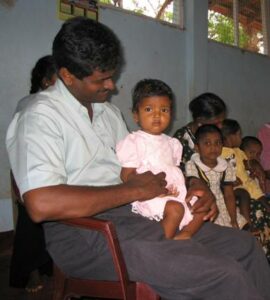 Ammunitions are not allowed on the Illam premises; the Tamil people believe education is paramount and the children are raised with this as their motto.
Ammunitions are not allowed on the Illam premises; the Tamil people believe education is paramount and the children are raised with this as their motto.
- For example, the standard of education needs improvement – libraries, science laboratories and computer systems are substandard and antiquated.Communication facilities are essentially nonexistent: they are isolated from the outside world.
- After further questioning, I understand that they may be separating a fund specifically for Illam contributions in the future.However, it was clear that the TRO has a separate channel to accept and donate funds to the Illams.The TRO is more widely known and occasionally receives funding from other international NGOs.
But, we thought that more involvement and contribution could come from abroad if they were more visible.The meeting ended with a plea by the coordinator to share what we saw here with the “people” back home.She feels the homeland has been forgotten by many and would like to see it have more “presence” in their minds.
There is a bunch of us that would be happy to help coordinate or find the appropriate people to assist or answer further questions.
E-mail the author at .
